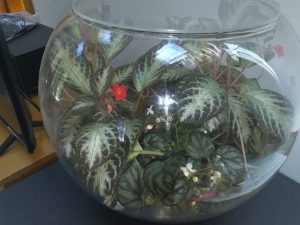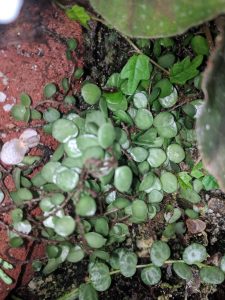
Terrariums are are contained environments that allow culture of plants. They take many sizes, shapes and dimensions and can be sealed or open. At the least terrariums are just plants in a bottle, in their highest form they are cultivated landscapes in miniature. Closed terraria create a unique environment and opportunity for plant growth. The transparent walls of the container allow for both heat and light to enter the terrarium while maintaining high relative humidity and preventing system water loss. Sealed containers combine retained moisture and heat which allows for the creation of a small scale water cycle. This happens because moisture from both the soil and plants evaporates in the elevated temperatures inside the terrarium. Water vapor then condenses on the container walls and eventually drips back onto plants and soil below. A sealed terrarium is ideal for growing some kinds of plants due to the constant supply of water, thereby preventing them from becoming dry. Lowland jungle plants from warm climates will do well. Some cloud forest plants, orchids and bromeliads will not fare well in sealed environments because they require more air movement and/or cooler temperatures. Terrarium culture can allow growth of plants difficult to cultivate even in greenhouses. Terrariums can be displayed to great effect and are an easy method of indoor gardening. Success with a terrarium garden requires an understanding of the container, light, media, and the plants themselves.

A Word about the Plants
A contained environment is not for all plants. When in a sealed environment, certain plants such as cacti or succulents will grow poorly or in a manner not suited to their habit (lanky or etiolated growth). Problems arise when plants not suited to a small contained environment are used. Plants such as Syngonium, Diffenbachia, and the larger Peperomia spp. look good when planted initially, but will soon outgrow their space–they are not suitable for closed terrariums. The classical “florist” terrarium planted with very young houseplants looks good at first but is completely unsustainable for months or years. A well designed terrarium should grow for multiple years before a complete tear down and replant is necessary. Thus it is necessary to select truly miniature and high-humidity-loving plants for closed terrarium culture. Ferns, sellaginellas, gesneriads, begonias and some peperomias are suited for these conditions. Obtaining truly miniature and humidity loving plants is difficult. Online vendors are the most accessible sources, but also other hobbyists or plant societies can be sources at their annual sales. Nurseries carry some of these plants but the vast array and diversity of rare plants are found on Ebay and Etsy. Many nurseries list plants under the ‘terrarium plants’ search words that are not really suitable, so take care to look for truly small or miniature plants. Perhaps start with the list I have provided at the end of this article for some of the tried and true plants that will work well. Terrarium gardens are not sustainable if you make bad plant choices, you will eventually end up removing plants that outgrow their containers.
The Container
Once you have your plants, you are ready to start. Or you can start before getting your plants and set up your terrarium now to plant later, or in stages, as you acquire new specimens to add into your contained garden. The first consideration is a suitable container. The larger the container the easier it will be to plant, grow and maintain your garden. Larger containers will also allow for a greater diversity of plant types. Fish aquariums may not be the most attractive, but are the most practical in many ways. Because they are rectangular they allow for placement of a light on the lid and they are easy to cover and place on square surfaces such as tables or window sills. Glass containers are preferred over plastic because they maintain transparency better over time. While bottles are attractive, if you can not get your hand inside they can be very difficult to plant and maintain.

The Media
Lowland, humid jungle plants grow in decomposing organic matter. For our purposes peatmoss is the best medium. It can be amended with fine horticultural perlite (20-30%) or sand. Sand will make a heavier mix, and, if you are doing a large terrarium, mix weight is important. If not, sand is ideal. Also, since terrariums are contained, they may become disease gardens if you are not careful. Therefore I recommend sanitizing your media in a microwave until the media temperature exceeds 160F. Keep the bag closed until the media cools. A turkey roasting or other microwave safe bag works well. Media can be sanitized in a conventional oven–it just takes longer. Media should be moist but not wet when microwaved. Distilled water can be added later to moisten the media after planting. Commercial mixes can be used for terrarium media but care should be taken. Search the blog for my article on potting soils.
Since terraria are sealed environments, you need a reservoir for the water and a filter. Create the reservoir with coarse horticultural perlite (#3) up to an inch thick (the bottom most layer) depending on size of the container –the bigger container, the thicker the layer. Cover the perlite with activated charcoal. Fish aquarium charcoal or horticultural charcoal from the nursery is fine, but NOT charcoal briquettes. The charcoal layer just covers the perlite. Now add soil. Slope the soil from thin in the front to thicker in the back. You can also add wood, sticks, and rocks to make interesting landscapes. They should all be sanitized in the dishwasher or boiled or microwaved until sterile. After placement of soil, rocks and sticks are ready to plant. Place larger growing plants in the center and rear and small vines up front.
Your container should be sealed either with “cling tight” plastic wrap or glass. I prefer glass for most applications.
Light
While terraria can grow in window light, especially north light, it is not optimal for most plants and they will grow slowly. You can’t place terraria in direct sunlight or the plants will “cook” because closed terraria can’t dissipate heat that rapidly. The old standard for light sources is fluorescent tube fixtures, but they have been supplanted by Light Emitting Diode (LED) technology. Grow-light LED fixtures are expensive, but provide some performance differences. Terrariums are not crops and we don’t want them to grow too fast so find an affordable light source that works for you. LED sources are nice because they are not bulky and do not add large amounts of heat. A bit less light or less optimal wavelengths of light are ok because we want to sustain plant growth for a long time, not grow the plants to the edge of the container real fast and have to prune or start over. The Costco brand shoplight LED fixture is perfect, but it is four feet long. Smaller LED fixtures would be appropriate for smaller containers. The Costco fixture is perfect for a 60 gallon fish tank. White light works well and looks best. Red and blue LED fixtures change the way we see the plants and are not best for viewing. Light should come from above so plants will appear to be growing normally. If the terrarium is placed near a window it will need to be rotated to keep plant growth even.
Moisture
Moisture is critical in terraria. The growing medium should hold a shape when squeezed but not be saturated when you plant. After the terrarium is planted, you can “water it in” with a dilute -1/4-strength fertilizer solution mixed into distilled water. Watering amounts will vary by container size. Water should penetrate soil to the depth of roots and some should enter the reservoir. No more watering is necessary again until some time later when plants have grown considerably—usually months later. I usually water the glass to clean it from the initial planting with a turkey baster. At some point in the future, months not weeks, the soil may dry as growing plants use up water. When this occurs, water again with another dilute fertilizer solution. Do not over water your terrarium or bad things will happen. Also resist misting or spritzing as this will cause leaves to rot and is not necessary in a sealed environment.
Pruning, Replanting and Maintenance
Some of your chosen plants may outgrow their space. Some like Ficus minima ‘quercifolia’ will just overgrow everything, the same can happen with common Sellaginella sold in nurseries such as S. brownii. You should plan on pruning back the plants and making cuttings or planting other terrariums with the prunings. Cut begonias below a node or along the rhizome. Rhizomatous ferns can be clipped or dug and planted elsewhere. If you have to remove a really big plant it will leave a hole. New sterilized mix should be added to fill the hole along with the new plant occupant. Removal of flowers, mushrooms (should they form) and dying leaves is important. They will cause rots on plants they fall on. Sticks are usually always a problem since it is very difficult to kill mushroom fungi living in them. Mushrooms are mostly non-toxic to plants, but they drop spores and these lead to rot on sensitive begonias and ferns. Clip back Begonia, Episcia Sellaginella, Peperomia or Ficus to prevent them from overgrowing other plants.
Recommended Plant List
If you can find them, here are some recommended plants for terrariums.
Begonias
B. prismatocarpa
B. prismataocarpa variegata
B. versacolor
B. ‘Raja’
B. ficicola
B. exotica
Ferns
Edanoya spp.
Humata parvula
Lemmaphyllum microphyllum
Microgramma spp.
Pecluma pectinata
Tectaria spp.
Quercifelix zelanica
Others
Peperomia prostrata
Sininngia pusila and all its variants
Episcia spp. (there are many, I like the pink ones)
Saintpaulia (african violets-only miniatures)
Sellaginella erythropus
Sellaginella spp. (there are many kinds, S. brownii is most common)
Ficus minima ‘quercifolia’
Thank you for this! I love the idea of terrariums. I’ve bought several books on them and tried making a terrarium in a large enclosed glass jar with just moss in it. It did not do well and the moss just slowly died. It was a discouraging experience. Much of your advice is contrary to the common advice given on terrariums. As I know your advice is scientifically based and the other advice I had read was probably not, I suspect this is the reason why I was not successful. Thanks again.
Really interesting. I have tried many times & will again. Your list is enormously helpful
I was researching how to build a terrarium and found this information from Oklahoma State University extension. In addition to using a sterilized potting mix, they recommend
“Other materials such as rocks, sand, or charcoal are not recommended for drainage as once believed. When layers of such material are used in terrariums, water drainage away from roots is actually hindered. The reason for this is that the potting medium is like a sponge with millions of air pockets. When wet, the water is held tightly until the potting medium becomes completely saturated. Only then will the water move to the next layer. By then, there is too much water even for the drainage layer to hold. The plants’ roots suffocate in the oxygen-depleted potting medium, rot, and eventually die”.
Can you comment? Thank you so much for your time. The Garden Professors ROCK
In this post Dr. Downer is creating a sealed environment, so there has to be a source of water. That’s what the perlite/activated charcoal provides. It’s not a “drainage layer” but a water reservoir to keep humidity high.
There is not water coming in from above, as you would find with an open terrarium or pots; in these cases the information from OSU would be accurate.
Thank you so much for a speedy reply. What a great service you provide